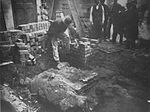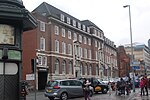Midlands Plateau
Natural regions of EnglandPlateaus of EnglandStaffordshire geography stubsWarwickshire geography stubsWest Midlands (county) geography stubs ... and 1 more
Worcestershire geography stubs
The Midlands Plateau is a plateau covering approximately 3,200 km2 in the Midlands of England, bounded by the Rivers Severn, Avon and Trent. The plateau is made up of three subdivisions: the Birmingham Plateau forms the central core, separated by the valley of the River Blythe from the East Warwickshire Plateau to the east, and by the valley of the River Stour from the Mid-Severn Plateau to the west.
Excerpt from the Wikipedia article Midlands Plateau (License: CC BY-SA 3.0, Authors).Midlands Plateau
Newton Street, Birmingham Digbeth
Geographical coordinates (GPS) Address Phone number Nearby Places Show on map
Geographical coordinates (GPS)
| Latitude | Longitude |
|---|---|
| N 52.483 ° | E -1.894 ° |
Address
Crown Court
Newton Street 1
B4 7NA Birmingham, Digbeth
England, United Kingdom
Open on Google Maps









